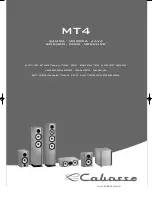
SV Sound
Chapter 6-2 Wiring
Connections, phase, wire and more
Regardless of the sort of wire you use, keep a consistent approach to
your wiring so you do not
inadvertently mismatch
your Plus (+) or Negative
(-) terminals on any
speaker and its run to the
r e c e i v e r ’ s
s p e a k e r
outputs.
After tightening down your
speaker terminals it’s
important to periodically
check on them. If you are
using bare, stripped wire
you may notice it will tend
to flatten over time.
Loose connections at
your speaker binding
posts can be a result.
Again look at the diagram
on the printed
Quick
Start
sheet to get an idea
of how you should
configure wiring with a
typical AVR and a basic
surround-sound system.
Your speaker is ―bi-wire‖ and ―bi-amp‖ capable with gold-plated bars
installed as a default for use with most consumer audio systems. Bi-
wiring your speakers (and removing the bars connecting the two sets
of binding posts) is unlikely to produce an improvement in sound
quality, but this configuration is often the choice of discerning
audiophiles. While not necessary for excellent sound, bi-amping your
speakers may result in better performance, with improved headroom
and dynamic range.
The upper terminal set is for the tweeter, and the lower terminal set is
for the mid-bass driver(s). Be sure to maintain correct wiring polarity
(+ to +, - to -) for all connections.










































